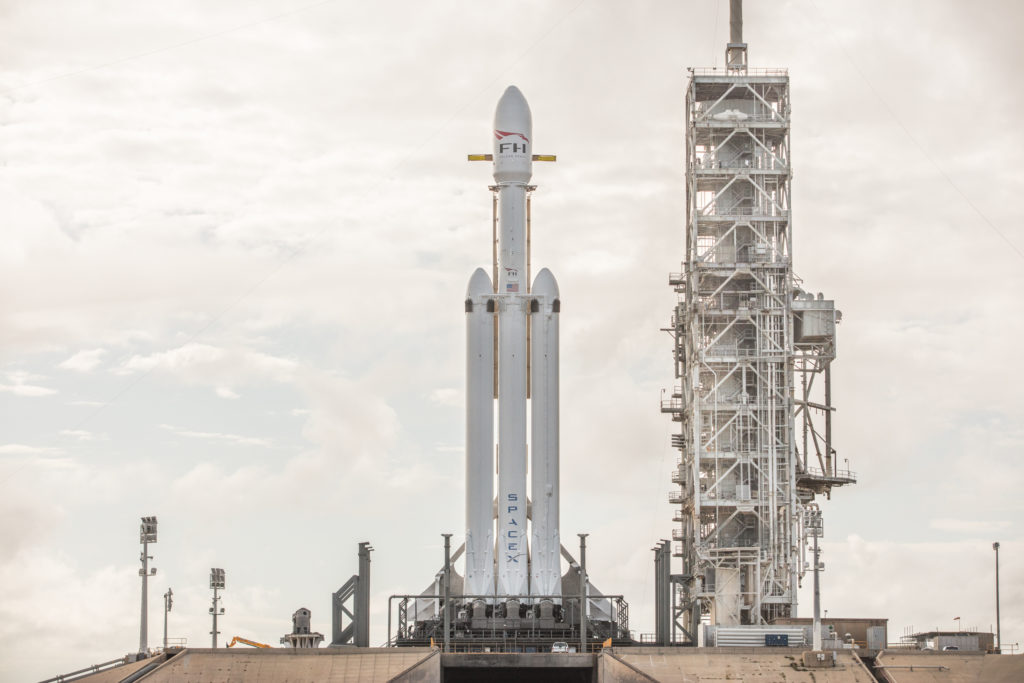SpaceX Falcon Heavy Makes History With Successful Test Launch
CEO Elon Musk’s private aerospace corporation SpaceX made history on Tuesday, Feb. 6 with a successful test launch of its Falcon Heavy space vehicle from NASA Kennedy Space Center (KSC) in Cape Canaveral, FL, paving the way for human space travel to Mars and possibly beyond.
The reusable rocket, deemed the world’s most powerful, blasted off from KSC’s Pad 39A at 3:45 EST after a number of weather-related delays threatened to scrub the launch due to high wind shear in the upper atmosphere. Once conditions improved, Musk took to Twitter to announce to the world that the mission was a go.
Musk tweeted, “Launch auto-sequence initiated (aka the holy mouse-click) for 3:45 liftoff.”
Launch auto-sequence initiated (aka the holy mouse-click) for 3:45 liftoff #FalconHeavy
— Elon Musk (@elonmusk) February 6, 2018
The anticipation seemed palpable—both in Mission Control and on social media—as the countdown commenced. Thousands of viewers tuned in to watch a live video stream on Facebook of the launch as thousands more gathered at KSC to witness the historic event.

The Falcon Heavy, a variant of the company’s successful Falcon 9 reusable rocket, was designed from its conception specifically to ferry humans into space, eventually to the moon and Mars. Consisting of a strengthened Falcon 9 core, two Falcon 9 side boosters, and 27 Merlin engines, the rocket packs a thrust of five million pounds at liftoff. This number is surpassed only by NASA’s Saturn V—retired in 1975—at 7.5-million pounds.
With an ability to carry payloads up to 140,660 pounds at $90 thousand per launch—a fraction of the cost of NASA’s competing Space Launch System (SLS), which would cost $1-2.5 billion per launch—the Falcon Heavy stands poised to meet the needs of all customers.
During a post-launch press conference, Musk stated that he feels the success of the Falcon Heavy will inspire others to enter the realm of commercial spaceflight.
https://www.youtube.com/watch?v=KORTP545vAc
“I think it’s going to open up a sense of possibility,” he noted. “I think it’s going to encourage other companies and countries to say ‘hey, if SpaceX which is a commercial company can do this’ […] then they can do it too. So I think it’s going to encourage other countries and companies to raise their sights and say, ‘hey, we can do bigger and better.’ Which is great. We want a new space race. Races are exciting.”
Part of that excitement resides with the whimsical payload used to test the rocket’s capabilities—Musk’s Cherry Red Tesla Roadster, manned by a spacesuit-clad mannequin named Starman. The automobile and its passenger will remain in space for a billion years. While the engine burn caused the vehicle to shift slightly off trajectory, it will eventually follow an elliptical orbit around the earth, sun, and Mars.
Musk admitted during the press conference that SpaceX considered scrapping the Falcon Heavy project numerous times throughout its development due to difficulty and costs.

“We tried to cancel the Falcon Heavy program three times at SpaceX because, it was like, man this is way harder than we thought,” he admitted when asked about the total investment. After a number of major redesigns on various parts of the rocket, the investment—which Musk says came completely from internal funding—came close to half of $1 billion.
As for plans for Mars and the moon, Musk seemed hopeful.
“I think we might, if we get lucky, we’ll also be able to do short hopper flights with the spaceship part of BFR maybe next year,” Musk stated, BFR referring to their Interplanetary Transport System.
The next SpaceX Falcon 9 launch is scheduled for Feb. 17 from Vandenberg Air Force Base, CA. While no concrete date has been set for the next launch of the Falcon Heavy from KSC, Spaceflight Now reports that it will take place sometime in the first half of 2018.

